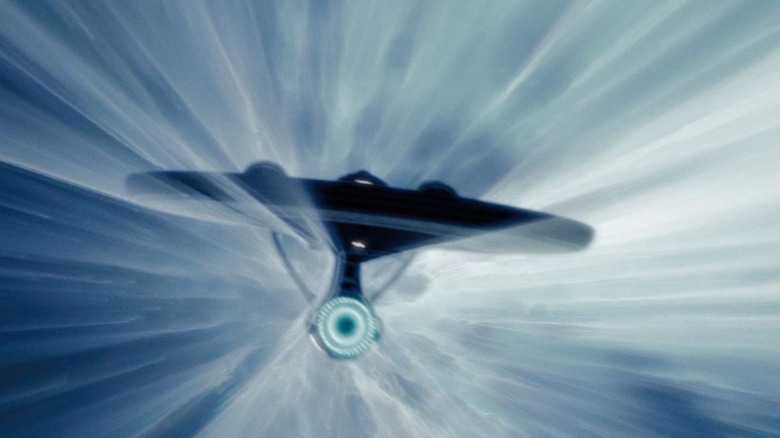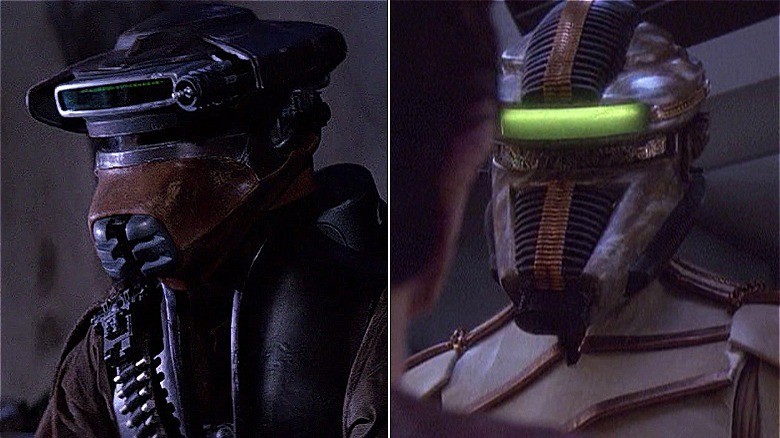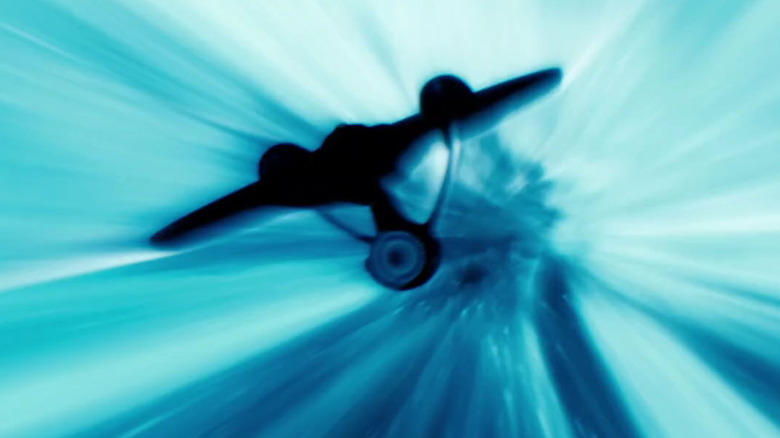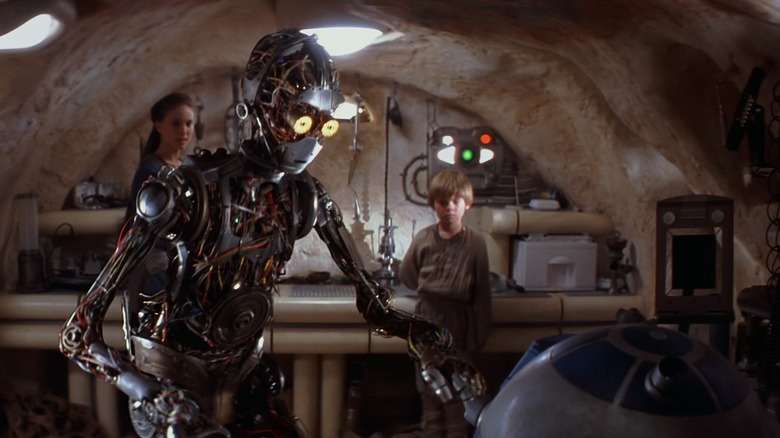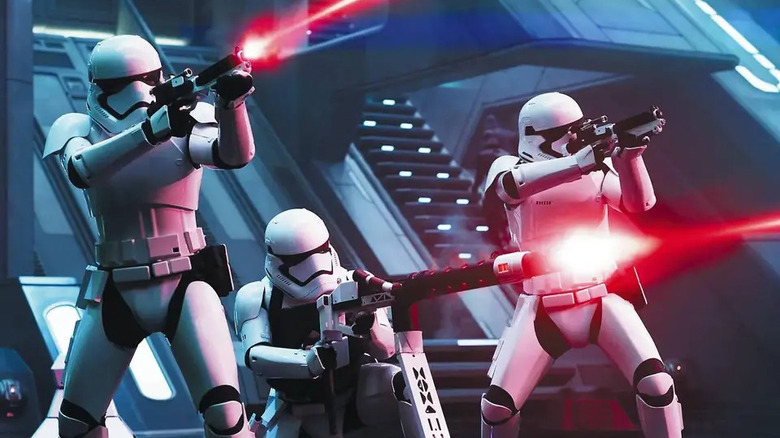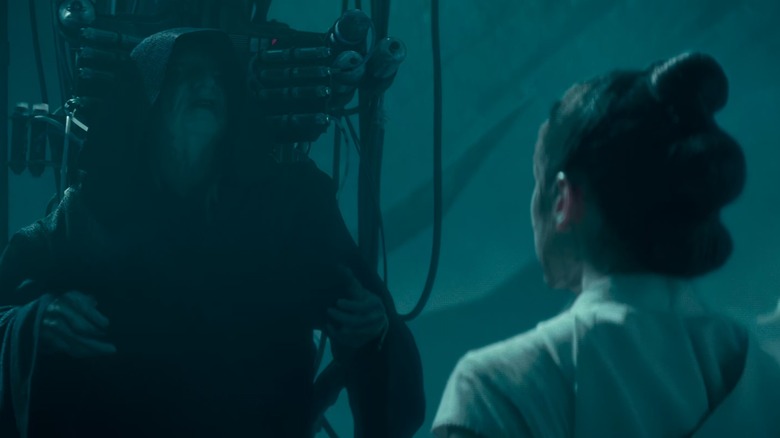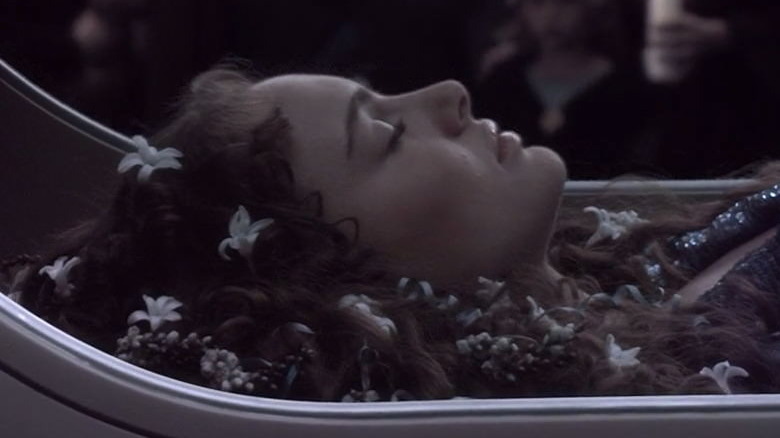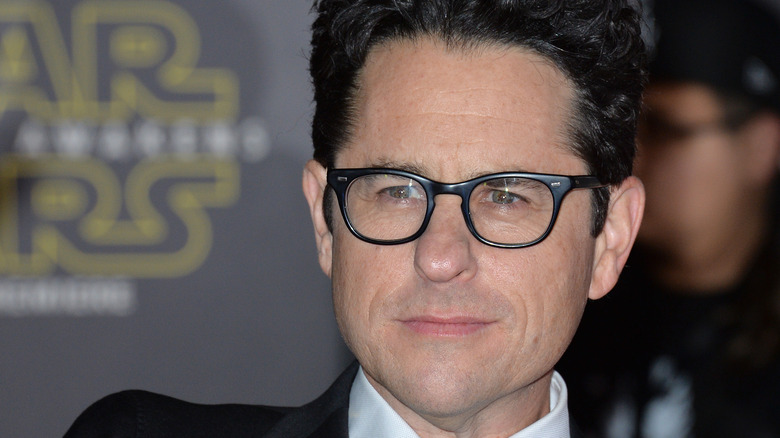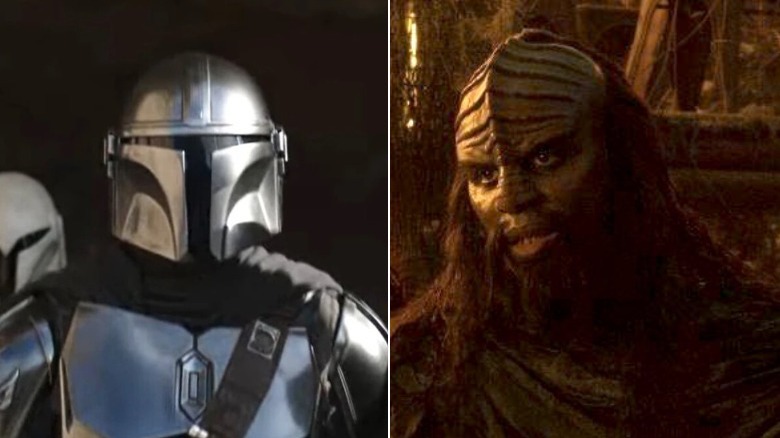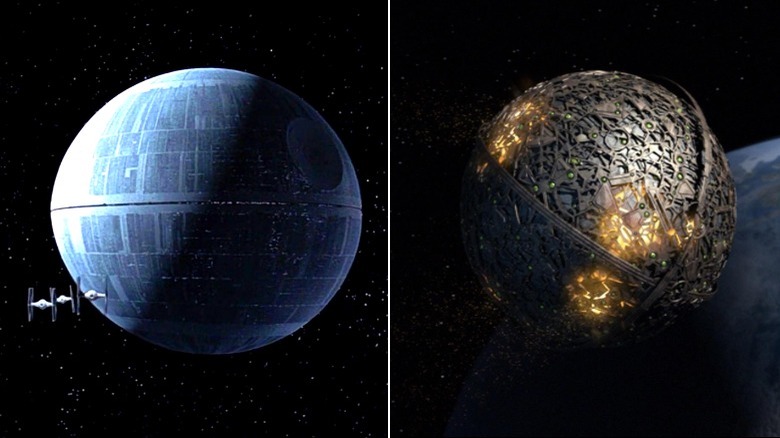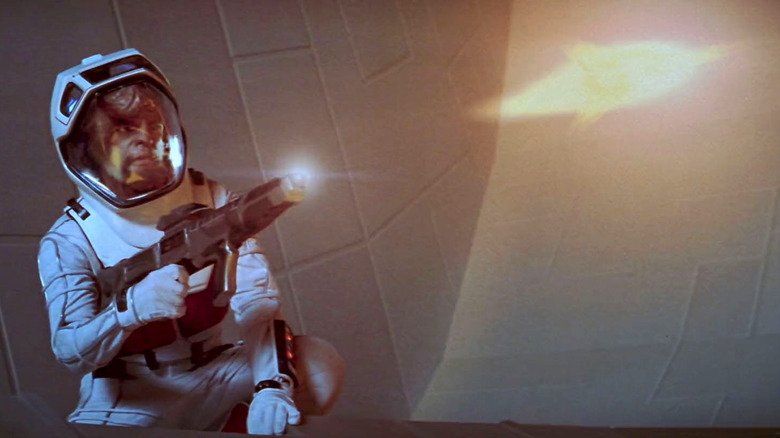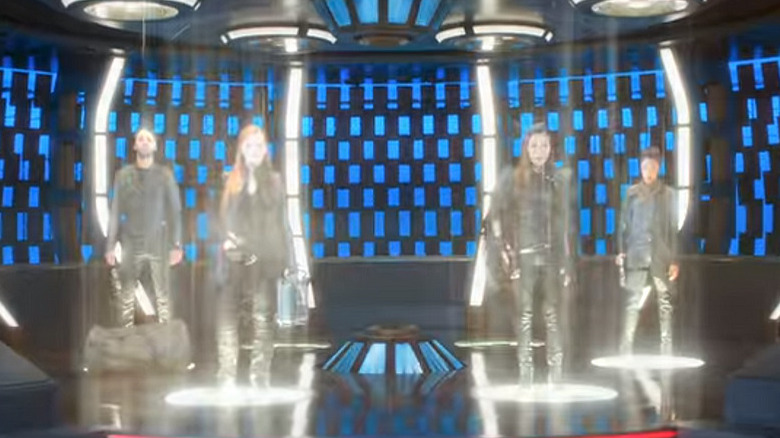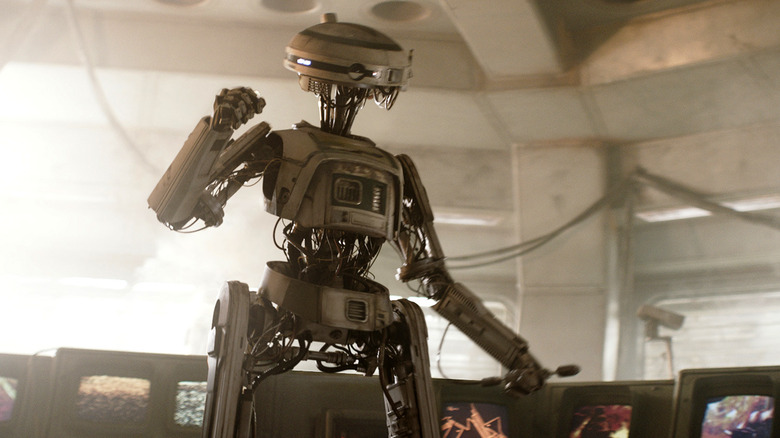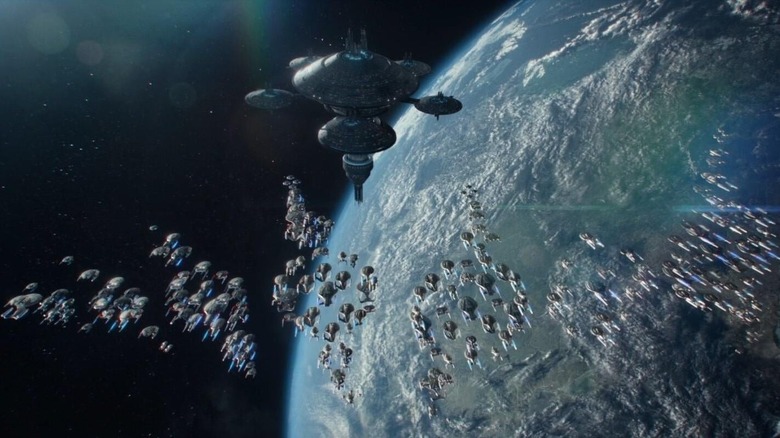13 Ways Star Wars And Star Trek Are Way Too Similar
It's a longstanding joke — and reality — that non-fans frequently confuse the franchise titles "Star Wars" and "Star Trek." This seems preposterous to devotees of either, many of whom will go on at great length about how completely different they are in terms of themes, outlook, technology, and tone. They may argue that "Star Wars" is a science fantasy with mystical knights who have laser swords and magic powers that leans heavily into destiny and predestination. Or that "Star Trek" is science fiction with extrapolated future technology and humans driving their own destiny. In the broadest strokes, that's true, but as a wise old Force Ghost once said, "You're going to find that many of the truths we cling to depend greatly on our own point of view."
A closer examination reveals that as both franchises have grown and sprawled they've increasingly rubbed up against one another and exchanged some cinematic and narrative DNA, with the result that the two really aren't always as distinct as they might've once been.
Boushh and the Breen
While no one's going to confuse an Imperial Stormtrooper for a Klingon warrior, there was one particular time when a masked "Star Trek" character bore a striking resemblance to a "Star Wars" counterpart with the introduction of the Breen. Name-dropped in several episodes of "The Next Generation" and "Deep Space Nine," it wasn't until the latter show's fourth season that they actually appeared.
And what an appearance. At first glance a lot of viewers familiar with "Star Wars" were likely struck with their resemblance to Boushh, the disguise assumed by Princess Leia (Carrie Fisher) in "Return of the Jedi" a dozen years earlier. Going on memory alone, anyone could be forgiven for thinking the Breen helmets were just reused Boushh helmets. In a side-by-side comparison it's obvious they're not identical, but they're damned close. That the Breen's sharp, metallic dialog was conveniently untranslated by the ubiquitous universal translators made the similarity even more pronounced.
Another similarity: In "Jedi" the figure we've believed to be Boushh pulls the helmet off to reveal Leia. A Breen pulls a similar reveal in the "DS9" episode "What You Leave Behind," only this time it's Kira Nerys (Nana Visitor). Coincidence? Homage? Separated at birth? You decide.
Space is Small. Really Small
As Douglas Adams observed, "Space is big. Really big. You just won't believe how vastly hugely mind-bogglingly big it is. I mean, you may think it's a long way down the road to the chemist, but that's just peanuts to space." But you wouldn't get that impression watching "Star Wars" or most of "Star Trek." Both treat screaming across light years like driving to the mall.
To be fair, "Wars" treated such journeys as trivial from the get-go, with the trip from middle-of-nowhere Tatooine to political hotspot Alderaan taking the length of one conversation. "Trek" didn't start off this way. It routinely took days for the Enterprise to go from planet to planet, and only occasionally hours if Scotty pushed the engines to "cannae take it" status. But by the 2000s warp drive had — for all intents and purposes — become hyperspace. Starfleet ships blast from Earth to the Klingon border seemingly as fast as the Falcon zipped to Alderaan. This has effectively erased one key distinction between the shows (although unlike the Millennium Falcon, Starfleet ships can still do pew pews in warp drive).
Of course, space is Douglas Adams big when it serves the needs of the story, as when the USS Voyager took 7 years (with massive shortcuts) to cross the galaxy. But that's become the exception, not the rule.
Small Universe Syndrome
In 1967, "Star Trek" Associate Producer Bob Justman complained when a writer tried to bring back the same Klingon commander from their first appearance:
"Here we are in the outer reaches of our galaxy [...] and who should Captain Kirk run into, but good old Kor — an adversary that he has encountered before ... Just think of it — billions of stars and millions of Class M-type planets and who should he run into, but a fella he has had trouble with before. No wonder Kor doesn't recognize him at first. The coincidence is so astounding, that he must feel certain that it couldn't possibly have happened. "
He could just as well be describing every "Star Wars" or "Star Trek" story since the '90s, since both are obsessed with linking absolutely everything. Characters from across each respective galaxy know each other or have some connection. Young Anakin Skywalker (Jake Lloyd) not only knew Greedo as a kid, but built Threepio (Anthony Daniels). Artoo hung out with Obi-Wan (Ewan McGregor) despite "A New Hope" Kenobi (Alec Guinness) barely giving him a second glance. Over in Starfleet, La'an (Christina Chong) is a descendant of the infamous Khan Noonien-Singh (Ricardo Montalban) and Michael Burnham (Sonequa Martin-Green) is the adopted sister of Spock, and the president of Earth is the son of Pavel Chekov (Walter Koenig). These people can't be important on their own, they have to be related to someone we know.
Grunts are Mostly Useless in Combat
Admittedly, this is a common trope in movies and TV well beyond these two franchises. And let's face it, audiences are there to see the heroes be heroic and perform acts of daring-do. We want to see Captain Kirk (William Shatner) take down that Klingon, not some nameless redshirt, just as we want to see Luke Skywalker (Mark Hamill) blow up the Death Star, not Gold Leader (Angus MacInnes). So the heroes end up being the best shots, and largely invulnerable, because they have to survive to win the day and receive medals or starship commands at the end.
This results in the similarity that only the leads can shoot straight, and everyone else can neither hit the broad side of a battle station nor avoid being cannon fodder, be they members of the Galactic Republic/Empire/New Order, Federation Starfleet, the Rebel Alliance, or the "Trek" alien menace of the week.
The OG "Star Wars" cleverly dodged this cliché bullet by revealing that the Imperials allowed the heroes to escape the Death Star in order to track them, which Leia surmises. But after that? And in Starfleet? What's the excuse?
Destiny's Children
Given its fantasy roots, "Star Wars" is unsurprisingly replete with characters marked by special destinies and fates. "Star Trek" began without this, but over time it's fallen prey to the easy trap of special destinies — so much so that "Strange New Worlds" Season 1 concluded with the message that Spock (Ethan Peck) is a chosen one who must survive at all costs. There was once a novel titled "Spock, Messiah!" and the franchise has embraced that too literally.
Bratty Anakin Skywalker is the Chosen One who will bring balance to the Force. It's implied that he had no father other than the Force. On "Deep Space Nine" Benjamin Sisko's (Avery Brooks) birth was caused by aliens who possessed his mother and made her bear a child with a man she didn't love. Why? Because the Emissary "could be no one else." There's no consent on the mother's part in either of these scenarios.
Even Rey (Daisy Ridley) can't just be a Jedi in training, she's got to be related to the saga's big bad. Wesley Crusher (Wil Wheaton) can't just be a child, but a "Mozart," as The Traveler (Eric Menyuk) puts it, of "time, energy, propulsion, and the instruments of this vessel which allow all that to be played." Such fates are anathema to the underlying philosophy of "Trek," which routinely suggests it's our choices that determine our futures and fates and that we're not shackled to predestination.
Parental Loss Abounds
Anakin Skywalker (Hayden Christensen) lost his mother twice. His children, Luke & Leia (Carrie Fisher), lost their mama, Padmé Amidala (Natalie Portman), at birth. Cassian Andor (Diego Luna) lost both parents as a child, then lost his adoptive father. Jyn Erso's (Felicity Jones) mother was killed and her father taken away. Ezra Bridger's (Taylor Gray) parents were imprisoned then killed. Rey was ditched by her parents. Finn (John Boyega) was taken from his family. Even Boba Fett (Daniel Logan) lost his father!
Meanwhile, Jonathan Archer's (Scott Bakula) dad died when he was young. Michael Burnham lost her parents at age 10. Kelvin Timeline James T. Kirk's (Chris Pine) pop died moments after his birth. La'an's family was torn apart by Gorn, and Uhura's parents and brother died in a shuttle accident. Benjamin Sisko's birth mother died before was 5, his adopted mother died, then his first wife died and left their son, Jake (Cirroc Lofton), motherless (and yet he's still more grounded than most "Trek" captains). Even B'Elanna Torres' (Roxann Dawson) deadbeat human dad (Juan Garcia) walked out on her family when she was a child. The cast of "The Next Generation" really took this to the extreme, with only Geordi LaForge (Levar Burton) reaching adulthood without losing one or both parents. Even android Data (Brent Spiner) had his "parents" abandon him.
Keep going deeper into the respective canons and you'll find even more. Seriously, there's no need to go all Bambi's mother on so many characters' parents.
J.J. Abrams is controversial in both fandoms
Outside of the films and shows themselves, one big commonality in fandoms of both franchises is the work of director J.J. Abrams, who directed two "Trek" movies and then a pair of "Wars" films. His efforts are frequently derided, and often for identical reasons. As a writer, he's criticized for derivative storylines lacking in originality, and that he merely moves the chess pieces around the board without inventing anything new. He's pilloried for a tiresome overreliance on MacGuffins and being unable to pay off the things he's set up. His "mystery boxes" are raked over the coals for being empty vessels, revealing nothing about the characters as they chase after them. As a director, he's attacked for an all style, no substance approach.
Beyond those broad strokes the fandoms have franchise-specific nits to pick. "Star Trek" fans accused him of making "Trek" too much like "Star Wars," and treating the two franchises as interchangeable. "Star Wars" fans accused him of effectively remaking previous films of the franchise without adding anything new. Phrases like "creatively bankrupt" got thrown around a lot in both fandoms.
The Mandalorians are Klingons
If "The Mandalorian" proved anything, it's that the honorable warrior race is a trope showing no signs of going quietly into the night. Both ridge-skulled Klingons and helmet-headed Mandalorians are caste societies centered around noble houses, and members of both live by codes of honor in the same way that the samurai class of feudal Japan cleaved to the code of bushido.
The two are so similar because, frankly, both franchises could've made more of an effort to develop their cultures beyond western genre stereotypes. The concept of a How does a society made up wholly of warriors work? Do Klingon chefs want to die in battle? Do Mandalorian nursemaids? Who keeps the books? Who picks up the trash? I was frustrated when "The Next Generation" first tried to sell me on it, and the "Mando" take doesn't work for me either.
Both would do well to look more closely at Edo-period Samurai culture, where they weren't just warriors, but a class in the caste system. Beyond their duties as fighters, they were also administrators, politicians, poets, and farmers. But neither the Mandalorians nor the Klingons efface such complexity. Another similarity? Let's face it — K'Ehleyr is Bo-Katan. There, I said it.
Overpowered Weapons
Both franchises have a fascination with preposterous planet-killing superweapons, be they Death Stars, Doomsday Machines, Starkiller Bases, Genesis Devices, preposterous Superlaser equipped Star Destroyers, Xindi death balls, or the much maligned and ridiculed Red Matter.
Other than the H-Bomb analogy of the planet-killer, OG "Trek" didn't dabble in planet-smashing weapons. Devastating a planet's surface was one thing, as when the Enterprise threatened to "glass" the surface of Eminiar Seven, or when the V'ger weapons would have devastated the entire surface of the Earth. But by the time of the show "Enterprise" and the 2009 "Star Trek" movie they'd gone full Death Star with planet-smashing weapons in the name of keeping up with the Palpatines.
Blowing planets apart is preposterous fantasy and would serve no practical function — even militarily — other than as an over the top terror weapon. Is the planet itself a problem, or the little carbon units that infest it? If what you're after is to kill everyone on a planet, think mass drivers. Or just fling a Star Destroyer-sized asteroid (or a Star Destroyer) at the target. The resulting blast, quakes, and hellfire raining from the sky will do the job quite handily. Just ask the dinosaurs.
Underpowered Weapons
For every Death Star or Doomsday Machine in each franchise there are 50 weapons which are little more effective than a small caliber handgun. This wasn't always the case in "Trek," where early on a single phaser shot or photon torpedo blasted unshielded ships to space smithereens, or a single hit could vaporize an entire person. But as time wore on the movies and shows increasingly portrayed phasers as firing energy bullets, with results that were effectively indistinguishable from the blaster hits of "Star Wars."
And speaking of blaster hits and phaser pulses, are they any more effective than a contemporary handgun? Stormtrooper armor seems utterly ineffective against ... well, everything, so why rely on this high-tech weaponry when a lead slug would do the job?
Okay, sure, if phasers worked as portrayed early on, it would be about as hard to miss with one as it would with a flashlight. In beam mode it's effectively a lightsaber of incredible length, where you could pull the trigger and sweep your arm around, which would require rethinking gunfights entirely. But why do that when "Star Wars" has made everyone want to go "Pew! Pew!"
They're Both Science Fantasies
"Star Wars" has always worn its fairytale pedigree on its sleeve, so no one cares if there's no science behind its fiction. "Star Trek," though, has always had pretensions to be science fiction, even if soft. But much of that "science" has been magic since day one. In science fantasy I can buy a Jedi sensing a million voices crying out in terror from light years away. In science fiction I can't buy a telepath sensing thought patterns at similar distances. Exotic tech warp drives can handwave Einstein aside, but since when are brainwaves faster than light? Looking at you, Vulcans.
Transporters are a physicist's nightmare, but if they were only used to move people and property from plot point A to plot point B, that wouldn't be so bad. It's all the other abilities the writers grafted onto it which beam it into fantasyland. It can split people into Jekyll-Hyde duplicates, merge two beings into one, undo aging, or whatever the plot requires of it each week.
And such nonsense isn't just limited to that. "Trek" routinely slathers scientific-sounding jargon over whatever nonsense the plot requires to lend the illusion that it's grounded in reality, but it's mostly rubbish. Statements like "synchronizing the transporter's annular confinement beam to the warp core frequency" is about as scientific as a Harry Potter-esque techno incantation like, "synchronizo trabes claustri annularis motoris ad stamen nucleum frequentia! "
All that's missing is a magic wand ... or the Force.
A.I. is a Subclass
"They do the work that no one else wants to do because it's too difficult, or too hazardous..." Guinan (Whoopi Goldberg) said of androids in the "Star Trek" universe. "You don't have to think about their welfare, you don't think about how they feel. Whole generations of disposable people." That just as easily applies to the droids of "Star Wars," because another similarity between the franchises is that being an artificial life form in either sucks.
"Star Wars" flat out treats droids as property, despite the fact that quite a number of them exhibit levels of both sentience and sapience. Up to a point you could pretend that droids were merely programmed to act like self-aware beings, until "Solo" introduced socially conscious L3-37 (Phoebe Waller-Bridge) making a passionate case for droid rights. "Andor" even features sensitive droid B2EMO (Dave Chapman) literally mourning the death of a human.
The "Star Trek" franchise repeatedly touches on A.I. rights, but never makes the big jump to extending rights and self determination to them as a class, generally opting to make exceptions for individual cases. The whole plot of "Picard" Season 1 revolves around bans against A.I. and attempts to annihilate them out of fear. Be it Data, or the self-aware programs known as Moriarty (Daniel Davis) and The Doctor (Robert Picardo), all have to argue for their rights, and not always to entirely satisfactory results.
Ginormous Space Navies
In the photochemical age, visual effects were difficult to accomplish and often very expensive. On OG "Trek" and even the movies it was vanishingly rare to see two or more ships simultaneously. This is why the sheer number of ships seen buzzing around in 1977's "Star Wars" was so revolutionary.
But with "Return of the Jedi" the bar was raised, and just having a dozen ships or asteroids whizzing around was no longer enough. That film's most complex effects shot, SB19, consisted of 63 different space ships made up from 170 small rolls of film, and was a nightmare to choreograph and composite.
By the late '90s the introduction of digital compositing made such shots far simpler to do, so much so that even TV shows could afford to have massive space navies squaring off against one another, as demonstrated on "Deep Space Nine" in episodes like "Way of the Warrior." Once CGI became more practical, the die was cast, and the makers of both franchises decided bigger is better to the point of absurdity. See the preposterously enormous fleets capping "The Rise of Skywalker," all three seasons of "Picard," and the first season closer of "Strange New Worlds." When the shooting starts, the distinctions between "Star Wars" and "Star Trek" gets increasingly blurred.
